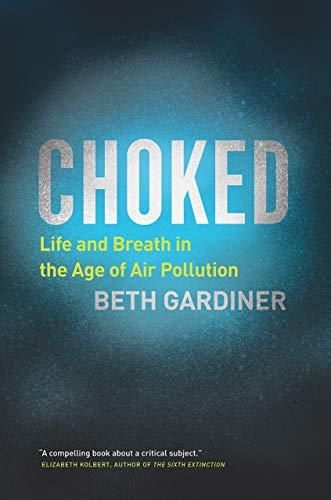Journalist Beth Gardiner provides a sobering, detailed, carefully researched overview of air pollution worldwide and its devastating health and economic consequences.

Mortal Air
Ubiquitous air pollution is a major public health problem that leads to millions of untimely deaths annually. Associated Press reporter Beth Gardiner details how air pollution poisons people, and links to cancer, heart disease and dementia. Her in-depth, calm reporting brings this deadly issue to life and reinforces the urgent need for solutions.
Air Pollution
People who live in cities breathe dirty, polluted air, which, day after day, proves a health hazard worldwide, and among environmental issues, the single greatest threat to human health.
No one would have been surprised, of course, to discover pollution’s effects were long-lasting…What shocked these careful men was the scale, the sheer force, of the impact.Beth Gardiner
The culprit isn’t only the ozone in the smog in cities such as Los Angeles, but airborne particles (PM2.5) and nitrogen dioxide (NOx) as well.
South Asia
India in particular, and South Asia in general, present an air pollution health calamity. Nine of the world’s 10 most polluted cities are in India. Indians suffer the worst lung health and the highest mortality rate from respiratory disease worldwide. Street-level exhaust from trucks and other vehicles in New Delhi proves especially dangerous, and disproportionately affects poor people. Small-scale manufacturing, small food stands and gasoline-powered generators providing electricity for buildings and construction sites are significant polluters.
The sheer number and variety of pollutants adding to the foul mix in Delhi’s air – and India’s – make the task of cleaning up more daunting than just about anywhere else.Beth Gardiner
Indian pollution emerges from the country’s need for development. Nearly a quarter of India’s population lacks electricity, and hundreds of millions live in poverty. Environmental concerns inevitably take a back seat to improving people’s quality of life.
London
As many as 9,416 Londoners die every year as a result of air pollution – nearly 20% of all London deaths.
Despite the huge SUVs crowding US roads, Britons are more than twice as likely as Americans to die from the effects of dirty air.Beth Gardiner
Cars using diesel fuel emit nitrogen dioxide (NOx). Britain set policies that incentivized buying cars with diesel engines. Almost 11 million diesel cars in Britain produce lethal emissions.
Poland
Krakow has the worst air in Poland, and Poland has more than half of the most polluted cities in Europe. Poland generates 85% of its electricity through coal, which provides nearly half of its heat. Mercury, lead and carbon monoxide make coal one of the most poisonous energy sources.
Coal fuels Poland’s power plants and the smoke spewing from their smokestacks floats as far as England, and is responsible for thousands of annual deaths beyond Poland.
California’s San Joaquin Valley
“Industrial-scale agriculture” dominates California’s sprawling, fertile San Joaquin Valley. It’s part of the Central Valley, which provides nearly 25% of America’s food. The San Joaquin Valley features America’s worst and most dangerous particle pollution.
The result has been a health and environmental disaster that goes well beyond the air.Beth Gardiner
The San Joaquin Valley is home to much industrialized farming. One farm involves a million acres of almond trees. Another grows enough vegetables to encase the world. Industrialized farming creates close to half the air pollution in the United States. And in Europe and the United States, this pollution causes a significant number of deaths.
Home Fires
Three times a day, every day of the year, hundreds of millions of people worldwide build fires to cook meals using use wood, charcoal, dung and vegetation. The smoke from these fires proves more hazardous than fumes from factories and cars. “Indoor air pollution” affects entire regions, harming women and children who are at home when the cooking takes place. The poor can’t afford gas or electricity.
Fully 80% of the sub-Saharan African population cook on open fires made from smoky biomass fuels from plants or animals, as does 60% of India’s population. Many Indians aspire to use stoves that burn liquefied petroleum gas (LPG), but few can afford them or acquire LPG canisters.
America’s Clean Air Act
In the late 1960s, when people began discussing what became the Clean Air Act, the environment wasn’t a common topic. But American air, lakes and rivers were dangerously polluted.
The Clean Air Act would bring an unprecedented level of accountability to the protection of Americans’ health.Beth Gardiner
Under the leadership of Senator Edmund Muskie, crafters of the law didn’t focus on technical or economic impacts, but on public health. The Clean Air Act would establish national standards for air pollution based upon public health considerations, which the law would prioritize over company profits. This gave the Clean Air Act its singular force. The law put the burden on industry to meet or exceed its standards.
Catalytic Converters
In the late 1940s, Eugene Houdry, who had introduced new petroleum processing to the oil industry, decided to address car engine pollutants. He chemically reconfigured the molecules of car exhaust into components that would not harm human health.
It [the catalytic converter] must be among the technological marvels that have done humanity more good with less glory than any other, saving lives every day in utter obscurity.Beth Gardiner
Lead – a gasoline additive – gummed up the catalytic converter and poisoned humans. All gasoline sold in the United States contained lead, and gasoline companies resisted any change, assaulting the science that proved lead’s toxicity. The Clean Air Act of 1970 made catalytic converters mandatory. General Motors president Ed Cole – pushed for the converter. By the mid-1970s, most cars sold in the United States featured catalytic converters.
China
China’s problematic air pollution affects hundreds of millions of people. In response, China’s leaders are reducing its epic coal use, and investing in wind and solar energy. By 2018, airborne particle levels in China had fallen by a third. Such a drop can increase people’s life expectancy by five years. China invested hundreds of billions in renewable energy and may become the world’s leading manufacturer of solar panels.
Review
Clearly inspired by Rachel Carson’s classic Silent Spring, Gardiner relies on a calm reportorial voice. Her deadpan style makes the horrors she describes all the more horrific. Gardiner reveals the worldwide scope and scale of the air pollution problem, which, she makes clear, kills residents of the developing and the developed world. Gardiner finds hope in the corrective actions of some of the worst polluters, such as China. But her outlook, grounded in pure fact, is realistic, not optimistic.
Worthy books on air pollution include Clearing the Air by Tim Smedley; Breathless by Chris Woodford; and The Invisible Killer by Gary Fuller.






